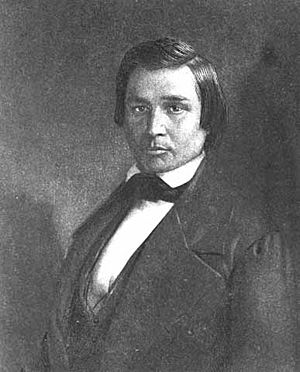George Copway facts for kids
Quick facts for kids
George Copway
|
|
|---|---|

George Copway ca. 1860
|
|
| Born | 1818 Trenton, Ontario
|
| Died | June 27, 1869 (aged 51) |
| Occupation | Native American author and historian |
| Known for | Publications on Ojibwa culture and history |
|
Notable work
|
The Life, History and Travels of Kah-ge-ga-gah-Bowh (1847) |
George Copway (born 1818 – died 1869) was an important Mississaugas Ojibwe writer and speaker. He was also a Methodist missionary who worked to help and speak up for Indigenous peoples. His Ojibwe name was Kah-Ge-Ga-Gah-Bowh, which means "He Who Stands Forever".
In 1847, George Copway wrote a book about his life. This book made him very famous in the United States. He was one of the first Indigenous authors from Canada to become well-known. In 1851, he published another book called The Traditional History and Characteristic Sketches of The Ojibway Nation. This was the first history of the Ojibwe people written in English.
Contents
George Copway's Life Story
George Copway was born near Trenton, Ontario, Canada. His family belonged to the Mississauga Anishinaabe people. His father, John Copway, was a chief and a traditional medicine man. In 1827, George's parents became Methodists. George started going to a local mission school in the 1830s.
In 1834, George went with his uncle and cousin to work as missionaries. They helped a Methodist minister teach the Ojibwe people near Lake Superior. For several years, he helped translate parts of the Christian Bible into the Ojibwe language. These parts included the Acts of the Apostles and the Gospel of Luke. In 1838, the Methodists helped George get more education in Illinois. Later, he became a minister.
In 1840, George Copway married Elizabeth Howell, an English woman. Her family were farmers near Toronto. They moved to Minnesota to continue their missionary work. They had two children: a son named George Albert and a daughter named Frances Minne-Ha-Ha.
The family returned to Canada in 1842. George Copway worked as a missionary for the Saugeen and Rice Lake Ojibwe communities. He was also chosen as the vice-president of the Ojibwe General Council.
Becoming a Famous Author
The Copway family later moved to New York City. Here, George wrote and published his first book in 1847. It was called The Life, History and Travels of Kah-ge-ga-gah-Bowh. This book was also published in London in 1850. It was the first book published by a First Nations person from Canada. The book was very popular and sold many copies in its first year.
During the 1840s, George Copway traveled a lot. He gave speeches and lectures across the United States. He also traveled to Europe. His travels gave him ideas for another book, Running sketches of men and places. This book described his experiences in England, France, Germany, Belgium, and Scotland.
Speaking Up for Indigenous Peoples
George Copway was a strong supporter of Indigenous peoples. He suggested creating a large territory for Native Americans in the American Midwest. This area would have been east of the Missouri River. At that time, European-American settlers were moving onto Indigenous lands.
Even though the United States Congress did not approve his idea, George Copway got a lot of attention. Many important thinkers and writers of the time, like the historian Francis Parkman, were interested in his ideas.
In 1851, George Copway started his own weekly newspaper in New York City. It was called Copway's American Indian. Famous writers and scholars supported his newspaper. These included Lewis H. Morgan, Henry Schoolcraft, James Fenimore Cooper, and Washington Irving.
George Copway continued to travel and speak. He passed away in 1869 in Ypsilanti, Michigan.
George Copway's Legacy
George Copway's books are very important. His 1847 memoir and his 1851 history book, The Traditional History and Characteristic Sketches of The Ojibway Nation, share many details about traditional Ojibwe culture.
He wrote about the use of birch bark scrolls. These scrolls were used to record songs, history, and important ceremonies. They had special symbols that told stories and held knowledge. Copway described how a few chosen people carefully made and kept these scrolls.
In 2018, the Canadian government recognized George Copway as a National Historic Person. This means he is remembered as someone very important in Canada's history.


